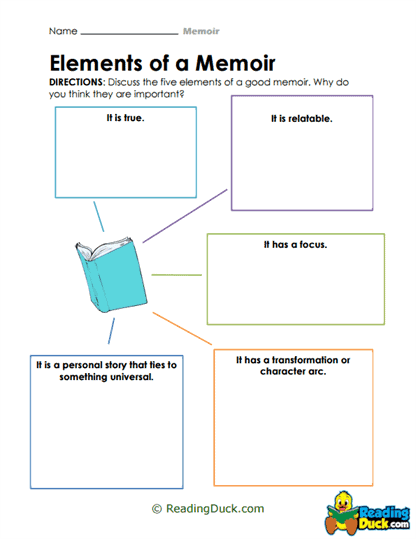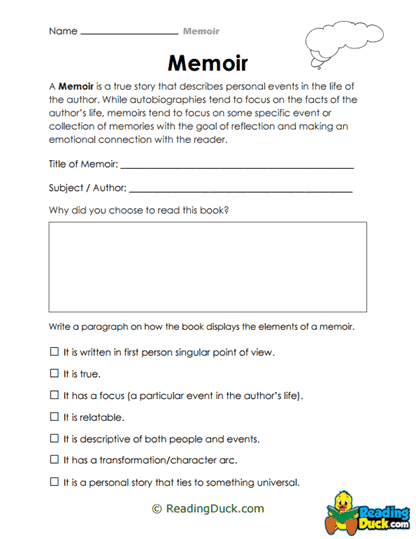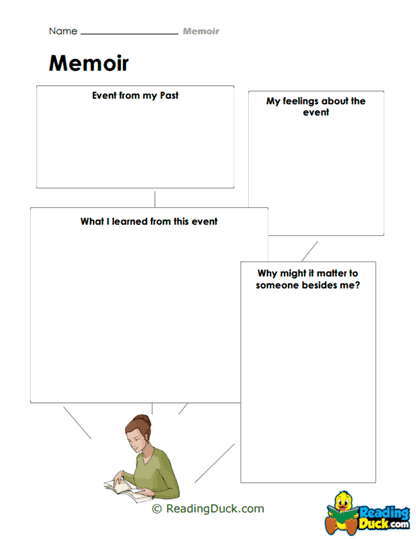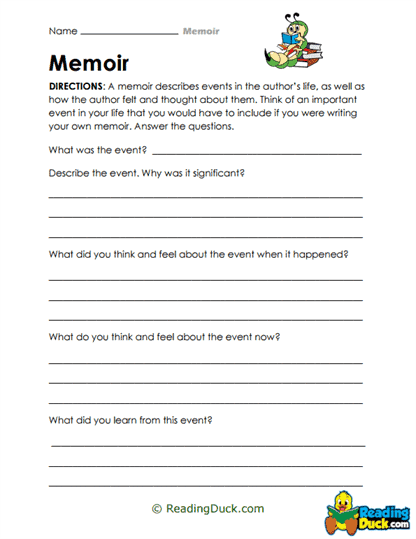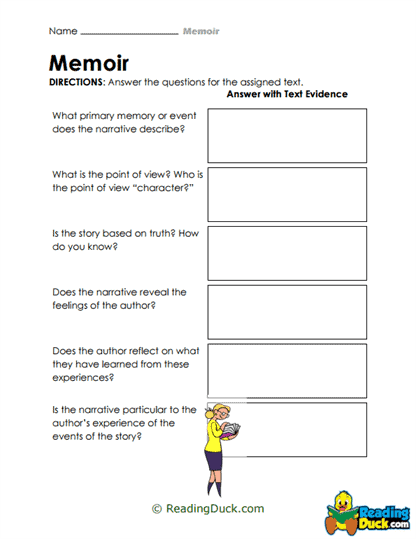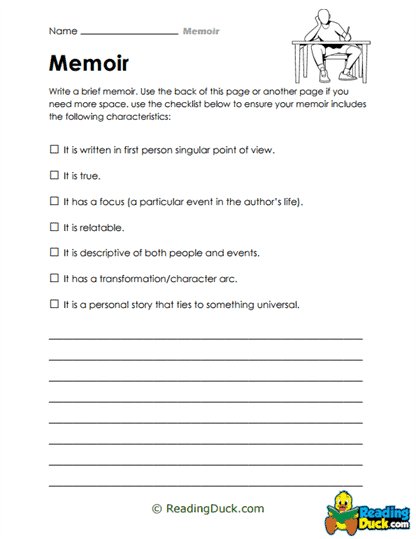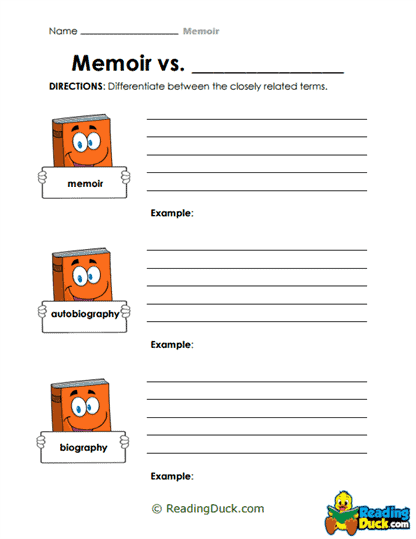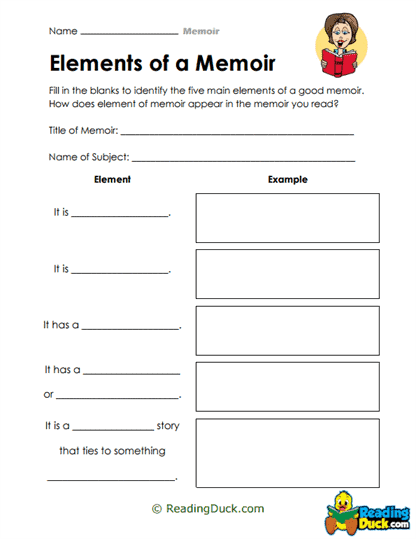Memoir Worksheets
About Our Memoir Worksheets
This collection of Memoir Worksheets, categorized under Literary Devices within the Skills section, is a carefully curated set of educational resources designed to enhance students' understanding and mastery of memoirs as a literary device. These worksheets provide comprehensive guidance, enabling students to explore and analyze the key elements that define a memoir, including narrative structure, voice, theme, and the use of literary devices such as imagery, metaphor, and symbolism.
By working through these worksheets, students will gain practical experience in crafting their own memoirs, reflecting on personal experiences, and understanding how to convey those experiences in a compelling, literary manner. The worksheets are designed to be user-friendly, presented in PDF format, making them easily accessible for viewing, downloading, and printing. Each worksheet comes with a downloadable answer key, allowing for straightforward self-assessment or guided instruction.
Understanding the Memoir: A Comprehensive Overview
A memoir is a literary form that captures personal experiences and memories, offering readers an intimate glimpse into the life and thoughts of the author. Unlike an autobiography, which typically covers the entirety of a person's life, a memoir focuses on specific events or periods that hold significant meaning. This distinction allows the memoir to delve deeply into emotions, insights, and reflections, making it a powerful tool for both writers and readers.
What is a Memoir?
- Personal Narrative: At its core, a memoir is a personal narrative that tells the story of the author's experiences. It often revolves around a particular theme or set of themes, such as family, identity, love, loss, or personal growth.
- Subjectivity: Memoirs are inherently subjective. They are based on the author's recollection and interpretation of events, which means they may blend fact with personal perspective. This subjective nature allows memoirs to be both deeply personal and universally relatable.
- Reflective Nature: Memoirs often include reflective passages where the author contemplates the meaning of the events they are recounting. This reflection can add depth to the narrative, allowing the reader to connect with the author's internal journey.
Memoir vs. Autobiography
- Scope: While an autobiography typically spans the author's entire life, a memoir focuses on a specific period or series of events. This narrow focus allows for a more detailed and introspective exploration.
- Tone: Memoirs often adopt a more informal, conversational tone compared to autobiographies. This tone helps create a sense of intimacy between the author and the reader.
- Purpose: The primary purpose of a memoir is to convey the emotional and psychological impact of events on the author, rather than simply recounting factual details. This makes the memoir a more literary and artistic form of writing.
Elements of a Memoir
- Voice: The voice in a memoir is crucial, as it reflects the author's personality and perspective. A strong, authentic voice can draw readers in and make the narrative more engaging.
- Theme: While memoirs are based on personal experiences, they often explore broader themes that resonate with readers, such as resilience, identity, or forgiveness.
- Imagery and Symbolism: Memoirs frequently use literary devices like imagery and symbolism to enhance the narrative. These devices can help convey complex emotions and ideas in a more vivid and relatable way.
- Structure: Memoirs are usually structured around a series of key events or moments, with the narrative often jumping back and forth in time to explore connections between past and present.
The Memoir as a Literary Device: Origins, Characteristics, and Examples
The memoir as a literary form has roots in ancient history, with early examples found in the works of Roman statesmen like Julius Caesar and Saint Augustine. However, the memoir gained prominence in the modern era, particularly in the 18th and 19th centuries, as people began to value personal narratives for their insights into individual lives and societal changes. The memoir's evolution continued into the 20th and 21st centuries, where it became a popular genre for both literary and popular audiences, reflecting the growing interest in personal stories and self-exploration.
Defining Characteristics
- Subjectivity: The memoir is defined by its personal perspective, offering readers an insight into the author's thoughts, feelings, and interpretations of events.
- Intimacy: A hallmark of memoirs is their ability to create a close connection between the author and the reader, often making the reader feel as though they are being confided in.
- Reflection: Unlike a straightforward recounting of events, memoirs involve reflection, allowing the author to explore the significance and impact of their experiences.
- Literary Quality: Memoirs often strive for a literary quality, employing various literary devices to craft a compelling and evocative narrative.
Popular Examples of Memoirs
- "The Diary of a Young Girl" by Anne Frank: A poignant account of a young girl's experiences during the Holocaust, this memoir is renowned for its emotional depth and historical significance.
- "Night" by Elie Wiesel: Another Holocaust memoir, "Night" is a powerful narrative that explores the horrors of concentration camps and the impact on the human spirit.
- "Becoming" by Michelle Obama: This contemporary memoir offers a candid look at the life of the former First Lady, exploring themes of identity, resilience, and public service.
- "Angela's Ashes" by Frank McCourt: A memoir that delves into the author's impoverished childhood in Ireland, capturing both the struggles and the strength of the human spirit.
The Role of Memoirs in Developing Early Literacy Skills
Memoirs play a significant role in developing early literacy skills among young learners. By engaging with memoirs, students can enhance their reading, writing, and critical thinking abilities in several ways:
- Reading Comprehension: Memoirs often require readers to interpret emotions, motivations, and the significance of events, which helps to develop deeper reading comprehension skills.
- Writing Skills: When students are encouraged to write their own memoirs, they learn to organize their thoughts, use descriptive language, and convey their experiences effectively. This practice enhances their narrative writing skills and encourages them to think critically about their life experiences.
- Empathy and Perspective-Taking: Reading memoirs allows students to step into someone else's shoes, fostering empathy and helping them understand different perspectives. This is crucial in developing emotional intelligence and social skills.
- Oral Communication: Discussing memoirs in class or in small groups helps students articulate their thoughts and experiences, improving their oral communication skills.
Engaging Activities to Reinforce Memoir Learning
To make the learning experience more dynamic and enjoyable, educators can incorporate a variety of activities to complement the memoir worksheets:
Suggested Activities
- Journal Writing (Grades 4-8): Encourage students to keep a daily journal where they reflect on their experiences, thoughts, and feelings. This practice can help them develop the habit of introspection, which is essential for writing memoirs.
- Group Storytelling (Grades 3-5): Organize a storytelling circle where students take turns sharing personal stories or anecdotes. This activity helps students practice narrative skills and build confidence in expressing themselves.
- Memoir Reading Club (Grades 6-8): Create a reading club focused on memoirs. Assign students to read different memoirs and discuss them in class, focusing on themes, narrative techniques, and the author’s voice.
- Family History Project (Grades 5-7): Have students interview family members and write a short memoir based on their findings. This project combines research, writing, and oral communication skills, while also helping students connect with their heritage.
- Visual Memoir Creation (Grades 3-6): Allow students to create a visual representation of a memoir, using drawings, photos, or collages. This can be a fun and creative way to express personal stories, particularly for younger students who may find writing challenging.
The Importance of Memoir Writing in Students’ Lives
In summary, memoir writing is a crucial skill that goes beyond the classroom. It encourages students to reflect on their personal experiences, fostering self-awareness and emotional intelligence. The process of writing a memoir helps students develop critical literacy skills, including narrative writing, reading comprehension, and oral communication. Moreover, memoirs provide a powerful means for students to connect with others, share their stories, and build empathy and understanding.
As students progress through their academic journey, the ability to express themselves through memoirs will serve them well in various contexts, from writing personal statements for college applications to communicating effectively in professional and personal settings. The skills gained from working on memoir worksheets are not only academically beneficial but also deeply enriching on a personal level, contributing to the overall development of well-rounded, articulate, and empathetic individuals.

